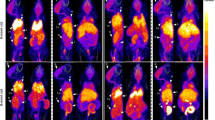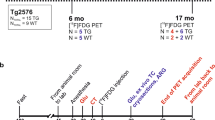Abstract
Copper is a nutritional metal required for brain development and function. Wilson’s disease (WD), or hepatolenticular degeneration, is an inherited human copper metabolism disorder caused by a mutation of the ATP7B gene. Many WD patients present with variable neurological and psychiatric symptoms, which may be related to neurodegeneration secondary to copper metabolism imbalance. The objective of this study was to explore the feasibility and use of copper-64 chloride ([64C]CuCl2) as a tracer for noninvasive assessment of age-dependent changes of cerebral copper metabolism in WD using an Atp7b −/− knockout mouse model of WD and positron emission tomography/computed tomography (PET/CT) imaging. Continuing from our recent study of biodistribution and radiation dosimetry of [64C]CuCl2 in Atp7b −/− knockout mice, PET quantitative analysis revealed low 64Cu radioactivity in the brains of Atp7b −/− knockout mice at 7th weeks of age, compared with 64Cu radioactivity in the brains of age- and gender-matched wild type C57BL/6 mice, at 24 h (h) post intravenous injection of [64C]CuCl2 as a tracer. Furthermore, age-dependent increase of 64Cu radioactivity was detected in the brains of Atp7b −/− knockout mice from the 13th to 21th weeks of age, based on the data derived from a longitudinal [64C]CuCl2-PET/CT study of Atp7b −/− knockout mice with orally administered [64Cu]CuCl2 as a tracer. The findings of this study support clinical use of [64Cu]CuCl2-PET/CT imaging as a tool for noninvasive assessment of age-dependent changes of cerebral copper metabolism in WD patients presenting with variable neurological and psychiatric symptoms.





Similar content being viewed by others
References
Ala A, Walker AP, Ashkan K, Dooley JS, Schilsky ML (2007) Wilson's disease. Lancet 369:397–408
Buiakova OI, Xu J, Lutsenko S, Zeitlin S, Das K, Das S et al (1999) Null mutation of the murine ATP7B (Wilson disease) Gene results in intracellular copper accumulation and late-onset hepatic nodular transformation. Hum Mol Genet 8:1665–1671
Bull PC, Thomas GR, Rommens JM, Forbes JR, Cox DW (1993) The Wilson disease gene is a putative copper transporting P-type ATPase similar to the Menkes gene. Nat Genet 5:327–337
Capasso E, Durzu S, Piras S, Zandieh S, Knoll P, Haug A, Hacker M, Meleddu C, Mirzaei S (2015) Role of 64CuCl2 PET/CT in staging of prostate cancer. Ann Nucl Med 29(6):482–488
Choi BS, Zheng W (2009) Copper transport to the brain by the blood-brain barrier and blood-CSF barrier. Brain Res 1248:14–21
Chuang N, Mori S, Yamamoto A, Jiang H, Ye X, Xu X, Richards LJ, Nathans J, Miller MI, Toga AW, Sidman RL, Zhang J (2011) An MRI-based atlas and database of the developing mouse brain. NeuroImage 54:80–89
Dong Y, Shi SS, Chen S, Ni W, Zhu M, Wu ZY (2015) The discrepancy between the absence of copper deposition and the presence of neuronal damage in the brain of Atp7b −/− mice. Metallomics 7:283–288
Faa G, Lisci M, Caria MP, Ambu R, Sciot R, Nurchi VM, Silvagni R, Diaz A, Crisponi G, Silvagni SS (2001) Brain copper, iron, magnesium, zinc, calcium, sulfur and phosphorus storage in Wilson's disease. J Trace Elem Med Biol 15:155–160
Fueger BJ, Czernin J, Hildebrandt I, Tran C, Halpern BS, Stout D, Phelps ME, Weber WA (2006) Impact of animal handling on the results of 18F-FDG PET studies in mice. J Nucl Med 47:999–1006
Gray LW, Peng F, Molloy SA, Pendyala VS, Muchenditsi A, Muzik O, Lee J, Kaplan JH, Lutsenko S (2012) Urinary copper elevation in a mouse model of Wilson's disease is a regulated process to specifically decrease the hepatic copper load. PLoS One 7:e38327
Hawkins RA, Mazziotta JC, Phelps ME (1987) Wilson's disease studied with FDG and positron emission tomography. Neurology 37(11):1707–1711
Hermann W (2014) Morphological and functional imaging in neurological and non-neurological Wilson's patients. Ann N Y Acad Sci 1315:24–29
Hermann W, Barthel H, Hesse S, Grahmann F, Kühn HJ, Wagner A, Villmann T (2002) Comparison of clinical types of Wilson's disease and glucose metabolism in extrapyramidal motor brain regions. J Neurol 249(7):896–901
Litwin T, Gromadzka G, Szpak GM, Jabłonka-Salach K, Bulska E, Członkowska A (2013) Brain metal accumulation in Wilson's disease. J Neurol Sci 329:55–58
Lorincz MT (2010) Neurologic Wilson's disease. Ann N Y Acad Sci 1184:173–187
Lutsenko S (2008) Atp7b −/− mice as a model for studies of Wilson’s disease. Biochem Soc Trans 36:1233–1238
Lutsenko S (2014) Modifying factors and phenotypic diversity in Wilson’s disease. Ann N Y Acad Sci 1315:56–63
Lutsenko S, Bhattacharjee A, Hubbard AL (2010) Copper handling machinery of the brain. Metallomics 2:596–608
Madsen E, Gitlin JD (2007) Copper and iron disorders of the brain. Annu Rev Neurosci 30:317–337
Manrique-Arias JC, Carrasco-Hernández J, Reyes PG, Ávila-Rodríguez MA (2016) Biodistribution in rats and estimates of doses to humans from 64CuCl2, a potential theranostic tracer. Appl Radiat Isot 115:18–22
Nomura S, Nozaki S, Hamazaki T, Takeda T, Ninomiya E, Kudo S, Hayashinak E, Wada Y, Hiroki T, Fujisawa C, Kodama H, Shintaku H, Watanabe Y (2014) PET imaging analysis with 64Cu in disulfiram treatment for aberrant copper biodistribution in Menkes disease mouse model. J Nucl Med 55:845–851
Olivares M, Uauy R (1996) Copper as an essential nutrient. Am J Clin Nutr 63:791S–796S
Peng F, Lutsenko S, Sun X, Muzik O (2012a) Positron emission tomography of copper metabolism in the Atp7b −/− knock-out mouse model of Wilson's disease. Mol Imaging Biol 14:70–78
Peng F, Lutsenko S, Sun X, Muzik O (2012b) Imaging copper metabolism imbalance in Atp7b −/− knockout mouse model of Wilson's disease with PET-CT and orally administered 64CuCl2. Mol Imaging Biol 14:600–607
Peng F, Muzik O, Gatson J, Kernie SG, Diaz-Arrastia R (2015) Assessment of traumatic brain injury by increased 64Cu uptake on 64CuCl2 PET/CT. J Nucl Med 56:1252–1257
Przybyłkowski A, Gromadzka G, Wawer A, Bulska E, Jabłonka-Salach K, Grygorowicz T, Schnejder-Pachołek A, Członkowski A (2013) Neurochemical and behavioral characteristics of toxic milk mice: an animal model of Wilson's disease. Neurochem Res 38:2037–2045
Roberts EA, Schilsky ML (2008) Diagnosis and treatment of Wilson disease: an update. Hepatology 47:2089–2111
Som P, Atkins HL, Bandoypadhyay D, Fowler JS, MacGregor RR, Matsui K, Oster ZH, Sacker DF, Shlue CY, Turner H, Wan CN, Wolf AP, Zabinski SV (1980) A fluorinated glucose analog, 2-fluoro-2-deoxy-D-glucose (F-18): nontoxic tracer for rapid tumor detection. J Nucl Med 21:670–675
Tanzi RE, Petrukhin K, Chernov I, Pellequer JL, Wasco W, Ross B, Romano DM, Parano E, Pavone L, Brzustowicz LM, Devoto M, Peppercorn J, Bush AI, Sternlieb I, Pirastu M, Gusella JF, Evgrafov O, Penchaszadeh GK, Honig B, Edelman IS, Soares MB, Scheinberg IH, Gilliam TC (1993) The Wilson disease gene is a copper transporting ATPase with homology to the Menkes disease gene. Nat Genet 5:344–350
Terwel D, Löschmann YN, Schmidt HH, Schöler HR, Cantz T, Heneka MT (2011) Neuroinflammatory and behavioural changes in the Atp7b mutant mouse model of Wilson's disease. J Neurochem 118:105–112
Toyama H, Ichise M, Liow JS, Vines DC, Seneca NM, Modell KJ, Seidel J, Green MV, Innis RB (2004) Evaluation of anesthesia effects on [18F]FDG uptake in mouse brain and heart using small animal PET. Nucl Med Biol 31(2):251–256
Uauy R, Olivares M, Gonzalez M (1998) Essentiality of copper in humans. Am J Clin Nutr 67:952S–959S
Wang LM, Becker JS, Wu Q, Oliveira MF, Bozza FA, Schwager AL, Hoffman JM, Morton KA (2010) Bioimaging of copper alterations in the aging mouse brain by autoradiography, laser ablation inductively coupled plasma mass spectrometry and immunohistochemistry. Metallomics 2:348–353
Yamaguchi Y, Heiny ME, Gitlin JD (1993) Isolation and characterization of a human liver cDNA as a candidate gene for Wilson disease. Biochem Biophys Res Commun 197:271–277
Zhou B, Gitschier J (1997) hCTR1: a human gene for copper uptake identified by complementation in yeast. Proc Natl Acad Sci U S A 94:7481–7486
Zhou XX, Li XH, Qin H, Li GD, Huang HW, Liang YY, Liang XL, Pu XY (2016) Diffusion tensor imaging of the extracorticospinal network in the brains of patients with Wilson disease. J Neurol Sci 362:292–298
Zhu M, Dong Y, Ni W, Wu ZY (2015) Defective roles of ATP7B missense mutations in cellular copper tolerance and copper excretion. Mol Cell Neurosci 67:31–36
Acknowledgements
The authors thank Xiankai Sun for use of the ICP-MS instrument. This research project was partially supported by the National Institutes of Health (1R21NS074394-01A1 and 1R21AG047953-01 to F.P). The production of [64Cu]CuCl2 at Washington University School of Medicine was supported by NIH/NCI grant R24 CA86307.
Author information
Authors and Affiliations
Corresponding author
Ethics declarations
Conflict of interest
The authors declare that they have no conflict of interest. The authors alone are responsible for the content and writing of the paper
Rights and permissions
About this article
Cite this article
Xie, F., Xi, Y., Pascual, J.M. et al. Age-dependent changes of cerebral copper metabolism in Atp7b −/− knockout mouse model of Wilson’s disease by [64Cu]CuCl2-PET/CT. Metab Brain Dis 32, 717–726 (2017). https://doi.org/10.1007/s11011-017-9956-9
Received:
Accepted:
Published:
Issue Date:
DOI: https://doi.org/10.1007/s11011-017-9956-9




